Pronouns Teaching Resources
Save time on your pronouns lesson plans with printable worksheets, digital activities, pronouns lists, grammar games and more from the teachers of Teach Starter.
This collection of teaching resources was teacher-created to help you help your students learn how to correctly identify and use this part of speech in their writing. With editable curriculum-aligned resources, you can meet the Australian curriculum standards while differentiating instruction for the individual students in your classroom.
New to teaching this part of the English curriculum or just looking for new ways to engage students as they learn about pronouns? Take a peek at this primer from our teacher team, including a definition of pronouns, types of pronouns and more!
What Is a Pronoun? A Kid-Friendly Definition
Knowing the definition of this part of speech yourself is only part of the battle. You'll also need to explain the meaning of pronouns to your students! So let's start with a kid-friendly definition.
Pronouns are special words that we use in place of nouns (people, places, or things) that we have already talked about. This part of speech makes our sentences shorter and easier to understand.
For example, instead of saying, 'Santos went to school, and then Santos did his homework,' we can use a pronoun to make the sentence shorter: 'Santos went to school, and then he did his homework.'
We also use pronouns to identify ourselves when speaking and writing. For example, you might say or write, 'I went to the beach with my family.' or 'We are a family.'
Types of Pronouns (With Examples) to Teach Your Students
When we write, there are various types of pronouns we use — each in different ways. Let's take a look at a list of some of the types of pronouns to add to your lesson plans!
Personal Pronouns
Personal pronouns refer to specific people or things.
- Examples of this type of pronoun include 'I,' 'you,' 'he,' 'she,' 'it,' 'we' and 'they.'
Possessive Pronouns
Possessive pronouns show ownership. Unlike many possessive nouns, they do not require you to use an apostrophe to show possession.
- Examples of possessive pronouns include 'mine,' 'yours,' 'his,' 'hers,' 'its,' 'ours' and 'theirs.'
Reflexive Pronouns
Reflexive pronouns are a part of speech that refers back to the subject of the sentence.
- Examples include 'myself,' 'yourself,' 'himself,' 'herself,' 'itself,' 'ourselves' and 'themselves.'
Demonstrative Pronouns
This type of pronoun points to specific people or things.
- Examples of this type include 'this,' 'that,' 'these' and 'those.'
Interrogative Pronouns
Interrogative pronouns are used to ask questions.
- Examples include 'who,' 'whom,' 'what,' 'which' and 'whose.'
Relative Pronouns
This type of pronoun can be used in writing to connect one clause to another in a sentence.
- Examples of relative pronouns include 'who,' 'whom,' 'that,' 'which' and 'whose.'
Indefinite Pronouns
These pronouns refer to people or things in a general or indefinite way.
- Examples include 'anyone,' 'everyone,' 'something,' 'anything,' 'nothing' and 'all.'
A Handy List of Pronouns for Teachers
Looking for a list of pronouns you can use to teach your students the most common examples of this part of speech and how they are used? Our teacher team has created that just for you!
- He is used to refer to a male person or animal Example: 'He is going to his dad's house after school.'
- She is used to refer to a female person or animal Example: 'She is performing an experiment.'
- It is used to refer to a thing or animal that is not male or female Example: 'The cat is sleeping; it is tired.'
- They is used to refer to a group of people or things
- Example: 'They are going to make tacos.'
- We is used to refer to a group of people that includes the speaker Example: 'We are playing football in gym class.'
- You is used to refer to the person being spoken to Example: 'You need to put on your jumper before you go outside.'
- Plus Plan
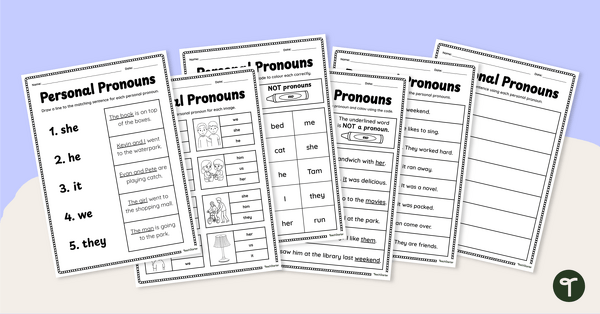
Personal Pronouns Worksheet Pack
Use these personal pronouns worksheets to get your students identifying and using these essential parts of speech.
- Plus Plan
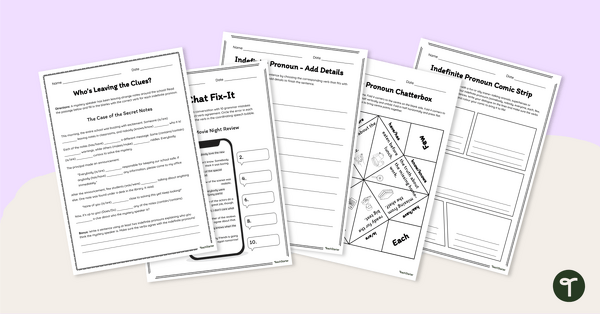
Indefinite Pronouns Subject Verb Agreement Worksheets
Support your students’ understanding of indefinite pronouns subject-verb agreement with this set of five worksheets featuring a variety of fun grammar activities.
- Plus Plan
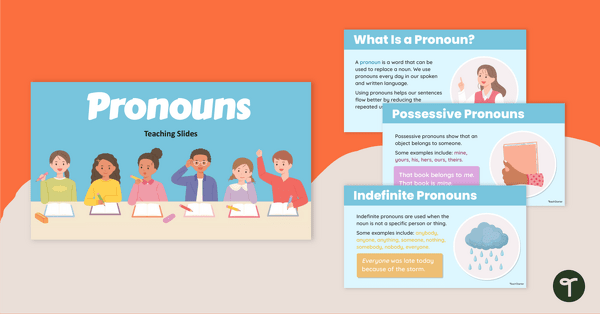
Pronouns Teaching Slides
Use this pronouns PowerPoint presentation to teach your students about some of the most common types of pronouns.
- Plus Plan
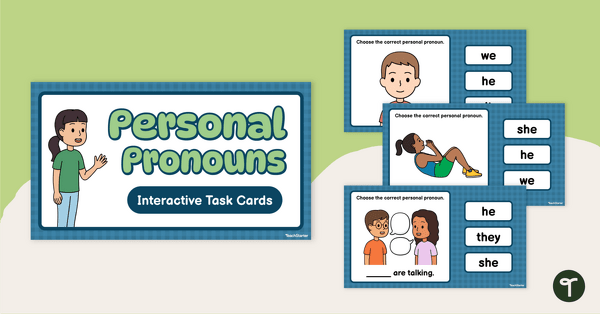
Personal Pronouns Interactive Task Cards
Use this online personal pronouns game to get your students identifying and using these important parts of speech.
- Free Plan
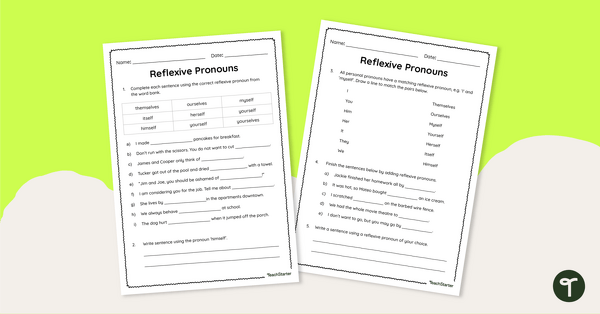
Reflexive Pronoun Worksheet
Use this reflexive pronouns worksheet to teach your students about reflexive pronouns and how they are used in sentences.
- Plus Plan
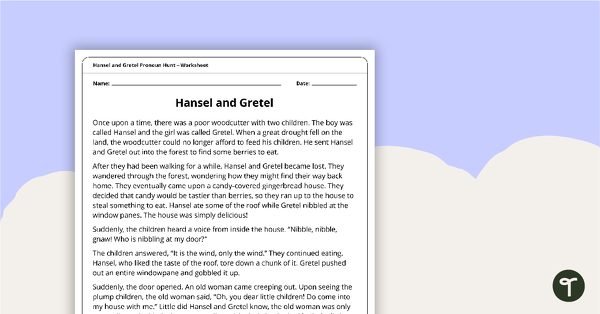
Pronoun Worksheet – Hansel and Gretel
Use this pronoun worksheet to get students identifying pronouns in the context of a well-known fairy tale.
- Plus Plan
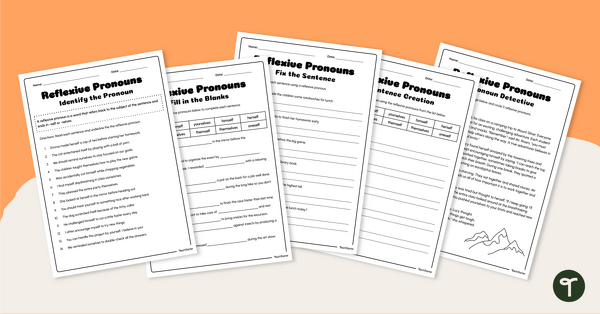
Reflexive Pronouns Worksheet Pack
Use this reflexive pronouns worksheet pack to get your students identifying and using these essential parts of speech.
- Plus Plan
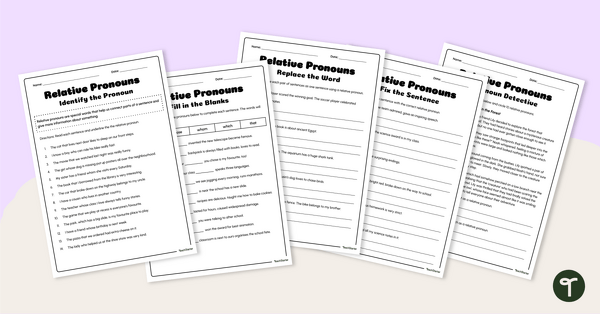
Relative Pronouns Worksheet Pack
Use this relative pronouns worksheet pack to get your students identifying and using these essential parts of speech.
- Plus Plan
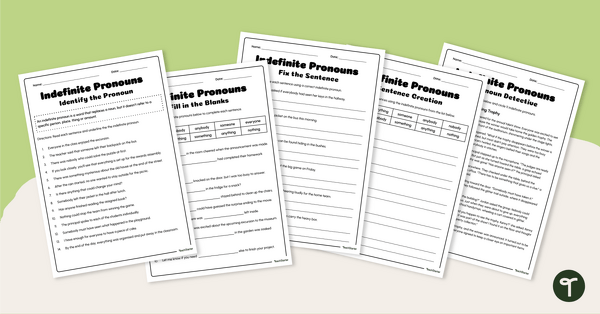
Indefinite Pronouns Worksheet Pack
Use this indefinite pronouns worksheet pack to get your students identifying and using these essential parts of speech.
- Plus Plan
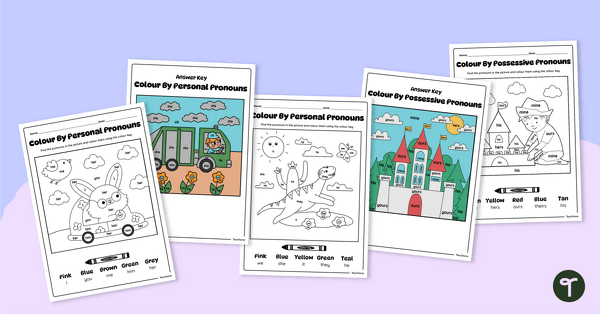
Colour by Pronouns Worksheet Pack
Use this set of colour-by-pronouns worksheets to help your students learn these important parts of speech.
- Plus Plan
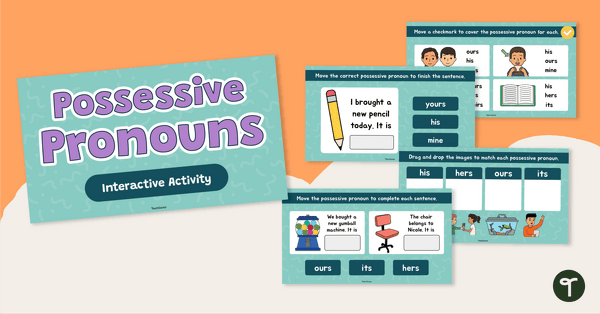
Possessive Pronouns Interactive Activity
Use these digital possessive pronouns exercises in your grammar lessons to give your students practice in using these essential parts of speech.
- Plus Plan
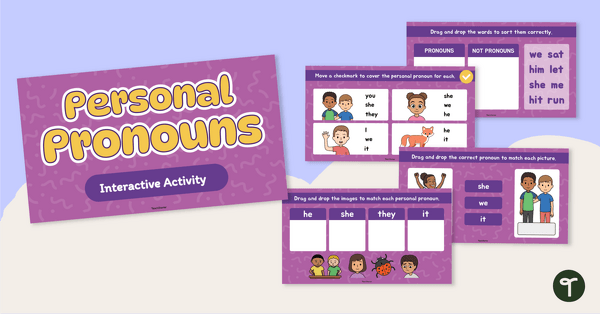
Personal Pronouns Interactive Activity
Use these digital personal pronouns exercises in your grammar lessons to give your students practice in using these essential parts of speech.
- Plus Plan
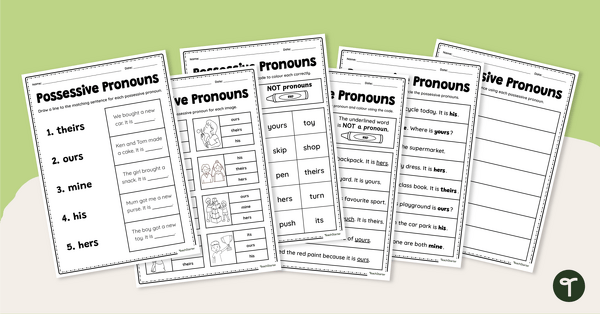
Possessive Pronouns Worksheet Pack
Use this possessive pronouns worksheet pack to get your students identifying and using these essential parts of speech.
- Plus Plan
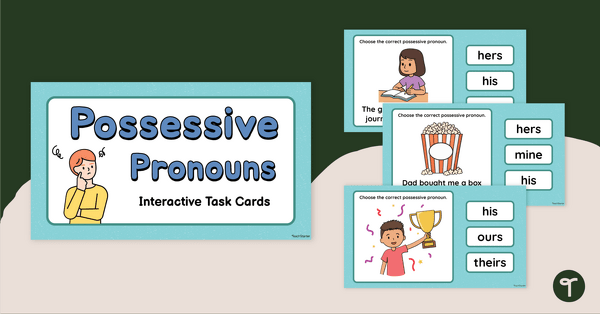
Possessive Pronouns Interactive Task Cards
Use this online possessive pronouns game to get your students identifying and using these important parts of speech.
- Plus Plan
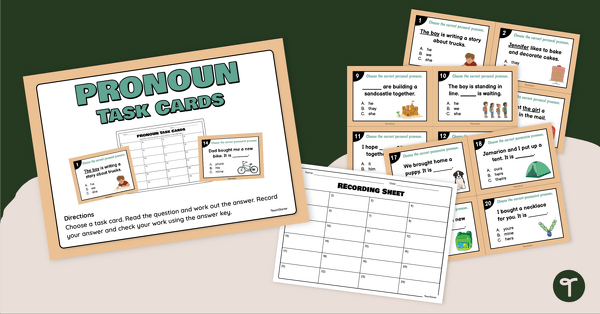
Pronoun Task Cards
Get your students to practise using pronouns with this set of task cards perfect for literacy groups.
- Plus Plan
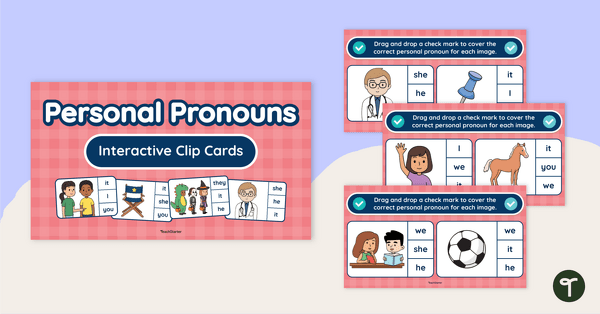
Personal Pronouns Interactive Peg Cards
Do some pronouns practice with your students using this set of 24 digital peg cards.
- Plus Plan
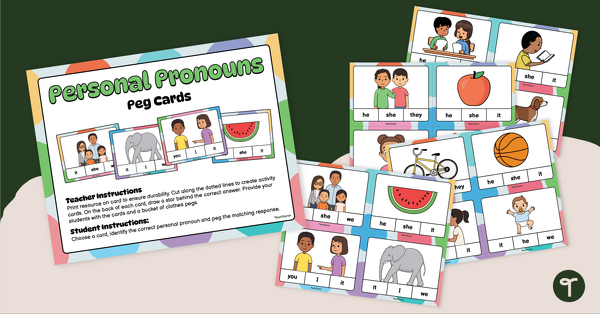
Personal Pronouns Peg Cards
Use these personal pronouns peg cards in your early years classroom when teaching students about parts of speech.
- Plus Plan
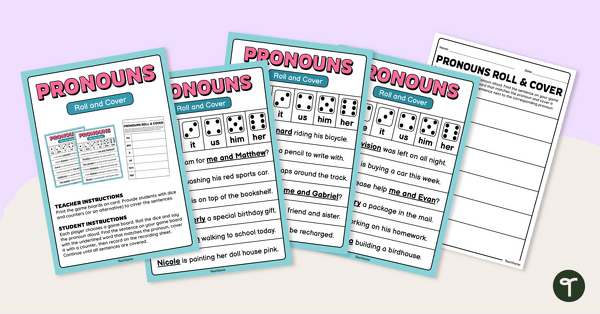
Personal Pronouns Roll and Cover Game
Use this pronouns game as a fun and collaborative way of learning about personal pronouns.
- Plus Plan
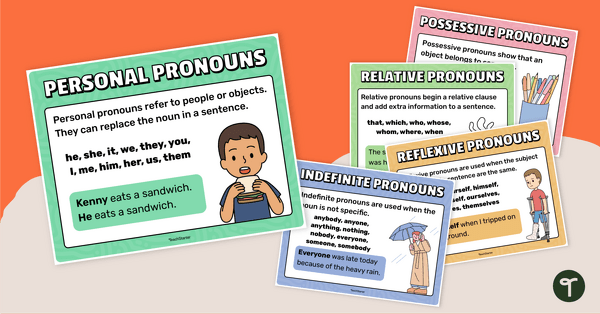
Pronouns Poster Pack
Display this set of 7 pronouns posters in your classroom to remind your students of the most common types of pronouns and their uses.
- Plus Plan
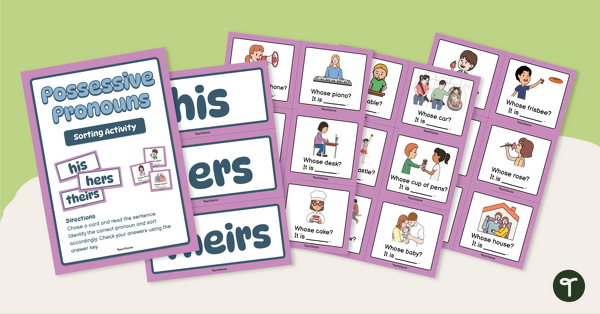
Possessive Pronouns Sorting Activity
Use this sorting activity in your grammar lessons to teach your students about possessive pronouns.
- Plus Plan
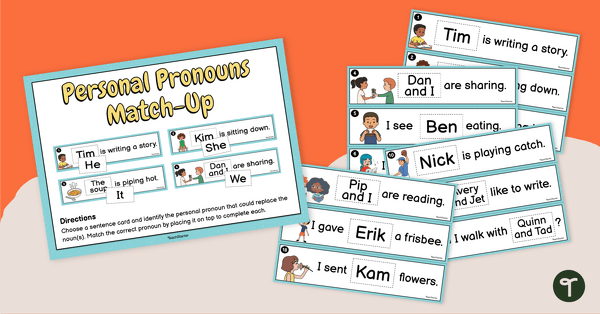
Personal Pronouns Matching Game
Familiarise your students with some of the most common personal pronouns using this fun matching game perfect for group work.
- Plus Plan
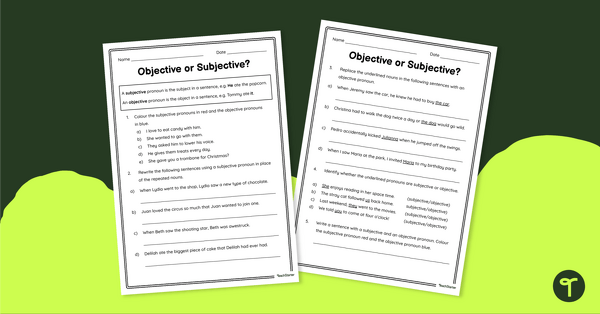
Subject and Object Pronouns Worksheet
Download this 2-page worksheet to get your students using objective and subjective pronouns.